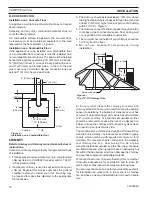
VSW40 Wood Stove
60300060
17
8. What is draft?
Draft is the ability of the chimney to exhaust by-products produced during the normal combustion
process.
9. What can cause a poor draft?
The most common factors for poor draft are:
a. Atmospheric pressure and air supply
b. Environmental condition
c. Cold chimney temperature
d. Poor chimney installation and maintenance
a)
Atmospheric Pressure and Air Supply
Atmospheric pressure affecting the draft from a chimney can be either outside the home, inside
the home or both. Outside the home, a high-pressure day (clear and cool) generally creates a
better draft in the chimney than a low-pressure day (overcast and damp). Inside the home normal
household appliances, such as clothes dryers and forced air furnaces compete for air, resulting in
inadequate amounts of air available to fuel a fire and create a condition known as negative pressure.
Under extreme conditions of negative pressure the combustion by-products can be drawn from
the chimney into the house. This condition is commonly referred to as down drafting.
There are several factors that impact the amount of air available in the home. Increased amounts
of insulation, vinyl windows, extra caulking in various places and door seals can all keep heat in
but may also make a home too airtight. If you are in doubt about whether or not there is sufficient
air in your home for your stove, curtail from using those appliances known to consume the air
where possible, or open a window or door to allow air to enter the home.
b)
Environmental Conditions
High trees, low lying house location such as in a valley, tall buildings or structures surrounding
your house and windy conditions can cause poor draft or down drafting.
c)
Cold Chimney Temperature
Avoid cold chimney temperatures by burning a hot fire for the first fifteen to forty minutes, being
careful not to over fire. If any part of the chimney or parts of the stove start to glow, you are over
firing the stove. Where possible, install a temperature gauge on the chimney so temperature
drops can be seen.
d)
Chimney Installation and Maintenance
Avoid using too many elbows or long horizontal runs. If in doubt, contact a chimney expert and/or
chimney manufacturer for help. Clean chimney, rain caps and especially spark arrester regularly,
to prevent creosote build-up, which will significantly reduce chimney draw and possibly a chimney
fire.
11. Should I close or open the air control fully when shutting down the stove?
Just before shutting down the stove, run on high for a few minutes. This allows the chimney
temperatures to remain as high as possible for as long as possible. Cold chimney temperatures
create creosote.
NOTE:
This sheet is intended as an aid and does not supersede any local, provincial or state
requirements. Check with officials or authorities having jurisdiction in your area.
FAQS




































